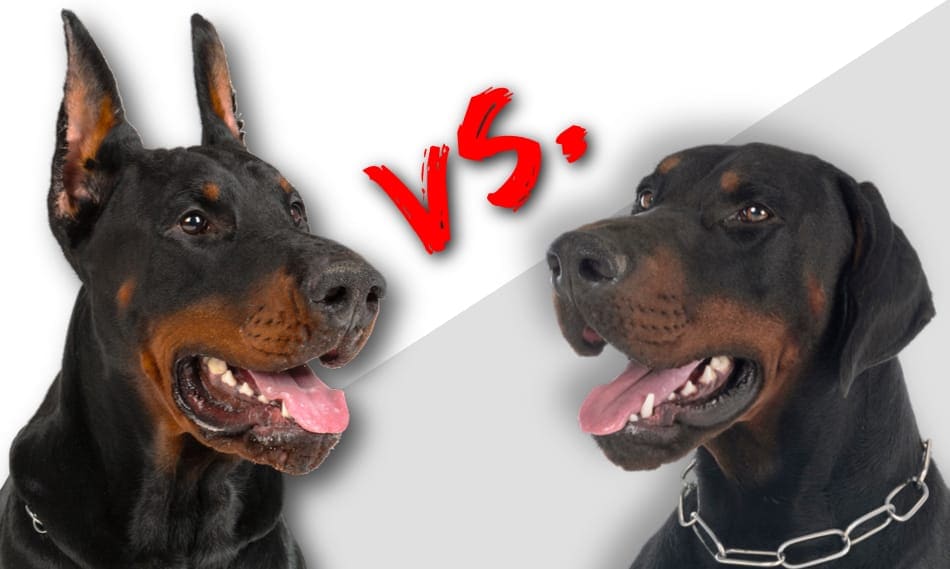Have you ever wondered why Doberman Pinschers have cropped ears? The practice of ear cropping in this breed dates back several centuries and has both practical and aesthetic reasons behind it. Let’s explore the fascinating history and rationale behind the tradition of cropping Doberman ears.
The history of ear cropping in Dobermans can be traced back to the breed’s origins as a working dog in 19th-century Germany. The Doberman’s natural ears, which are rounded and floppy, were prone to injuries and infections while they performed their duties as guard dogs and police dogs. Cropping the ears helped reduce the risk of these issues and allowed for better hearing and protection. Moreover, the cropped ear look became popular for its intimidating appearance, making Dobermans look even more fierce and alert. While the practice of ear cropping is controversial today, many Doberman enthusiasts still choose to crop their dogs’ ears for perceived practical and aesthetic reasons.
Doberman ears are cropped for both historical and practical reasons. Historically, cropping the ears of Dobermans was done to enhance their appearance and give them a more alert and intimidating look. It was also believed to reduce the risk of ear infections, as cropped ears allow air to circulate freely. However, ear cropping is now a controversial practice and is banned in some countries. Ultimately, whether to crop a Doberman’s ears is a personal choice, and it should be done by a professional veterinarian.

Why Are Doberman Ears Cropped?
Doberman pinschers are known for their sleek appearance, athleticism, and intelligence. One notable characteristic of Dobermans is their cropped ears. But why are Doberman ears cropped? This practice has a long history and has been a subject of debate and controversy. In this article, we will explore the reasons behind ear cropping in Doberman pinschers and the different perspectives surrounding this topic.
History of Doberman Ear Cropping
The practice of cropping Doberman ears can be traced back to the breed’s origins in the late 19th century. Louis Dobermann, the breed’s creator, wanted to develop a dog that would be ideal for protection, guard work, and companionship. To achieve this, he crossed several breeds, including the Rottweiler, Weimaraner, and German Pinscher. However, ear injuries were common in guard dogs at the time, so cropping the ears became a common practice.
Moreover, cropped ears were believed to give the Doberman a more alert and intimidating appearance, which was desirable for their roles as guard dogs and protectors. By cropping the ears, it was thought that potential intruders would perceive the Doberman as more formidable and think twice before approaching.
Over time, the practice of ear cropping became ingrained in the breed standard and was widely accepted and even required for show dogs. However, attitudes towards ear cropping have shifted in recent years, with many countries banning the practice or considering it unethical.
Reasons for Ear Cropping
There are several reasons why Doberman ears have traditionally been cropped:
- To prevent ear injuries: Cropping the ears is believed to reduce the risk of ear injuries such as hematomas, infections, and damage during rough play or working activities.
- Enhance appearance and breed standards: Historically, cropped ears were considered a standard characteristic of Doberman pinschers and were desired for a more “alert” appearance in the show ring.
- Ease of communication: Some argue that cropped ears allow for better expression of the dog’s emotions and facilitate communication between the dog and its owner or handler.
Controversies and Perspectives
The issue of ear cropping in Doberman pinschers is highly controversial, and there are varying perspectives on the practice:
1. Health and Ethical Concerns
Opponents of ear cropping argue that the procedure is unnecessary and causes unnecessary pain and discomfort for the dog. They argue that Dobermans can live perfectly healthy lives with their natural, uncropped ears and that the procedure should be avoided due to the potential risks and complications involved.
Furthermore, these opponents claim that cropping the ears solely for aesthetic purposes is unethical and prioritizes human preference over the well-being of the dog.
2. Breed Standard and Tradition
On the other hand, proponents of ear cropping argue that it is an essential aspect of preserving the breed standard and its historical tradition. They believe that cropped ears contribute to the overall appearance and character of the Doberman pinscher and should be preserved as a characteristic of the breed.
They also argue that the decision to crop a dog’s ears should be left to the owner, as long as the procedure is performed by a professional veterinarian under appropriate conditions.
The Future of Ear Cropping
The stance on ear cropping in Doberman pinschers varies by country and even within different kennel clubs and breed associations. Some countries, such as Australia, New Zealand, and parts of Europe, have banned the practice, deeming it unnecessary and inhumane. In other countries, such as the United States, ear cropping remains legal but is increasingly discouraged.
As the debate surrounding ear cropping continues, it is important for potential Doberman owners to research and consider the health implications, legal regulations, and ethical concerns associated with the procedure. Consulting with veterinarians, breeders, and fellow dog enthusiasts can provide valuable insights and perspectives.
In Summary
Ear cropping in Doberman pinschers has a rich history and is tied to the breed’s original purpose as guard dogs. The practice was believed to serve functional and aesthetic purposes, including reducing the risk of ear injuries and enhancing the Doberman’s appearance. However, the controversy surrounding ear cropping has grown in recent years, with concerns about animal welfare and ethical considerations becoming more prominent. Ultimately, the decision to crop a Doberman’s ears should be well-informed, taking into account the current legal regulations, health implications, and individual perspectives.
Key Takeaways: Why are Doberman ears cropped?
- Doberman ears are cropped for both historical and practical reasons.
- Cropping the ears gives Dobermans a more alert and sleek appearance.
- Historically, cropped ears were believed to enhance the breed’s ability to hear and localize sound.
- Cropped ears also reduce the risk of ear infections and injuries in working Dobermans.
- Cropping is a personal choice and not essential for the health of the dog.
Frequently Asked Questions
Dogs of certain breeds, including Dobermans, often have their ears cropped for various reasons. In this section, we will answer some common questions regarding why Doberman ears are cropped.
1. What is the purpose of cropping Doberman ears?
Cropping refers to the surgical procedure of shaping and removing a portion of a dog’s ear. For Dobermans, cropping is done for both cosmetic and practical purposes. Cosmetically, it is done to adhere to breed standards and enhance the dog’s appearance, giving them the characteristic pointed, erect ears. Practically, it can minimize the risk of ear infections and injuries. Cropped ears tend to have improved airflow and are less prone to debris buildup and damage during certain activities like protecting homes or working in security roles.
It’s important to note that ear cropping is a personal choice for owners and not required. It should always be done by a professional veterinarian using safe and ethical practices.
2. At what age are Doberman ears typically cropped?
The ideal age for ear cropping is typically between 7 and 12 weeks old. This age range is chosen because it allows the puppies’ ears to be fully developed and provides optimal healing and shaping conditions. The exact timing may vary slightly depending on the individual puppy’s growth and the preference of the veterinarian performing the procedure.
It’s essential to consult with a reputable veterinarian who has experience with ear cropping to determine the best age for the procedure.
3. Is ear cropping painful for Dobermans?
Ear cropping is a surgical procedure that involves cutting and reshaping the ear tissue. While it is done under anesthesia, there is still a certain level of discomfort and pain associated with the recovery process. Proper pain management is essential during and after the procedure to ensure the dog’s well-being.
It’s crucial to follow post-operative care instructions provided by the veterinarian to minimize pain and promote proper healing.
4. Can Dobermans hear well after their ears are cropped?
Doberman ears are cropped in a way that preserves their ability to hear. The amount of ear tissue removed during the cropping procedure is carefully calculated to maintain optimal ear function. While cropped ears may have a slightly different appearance, it does not significantly impact the dog’s ability to hear.
It’s important to note that proper training and socialization are crucial for any dog’s well-rounded development, including their ability to respond to auditory cues.
5. Is it possible to have a Doberman with natural ears?
Absolutely! Ear cropping is not mandatory for Dobermans, and many owners choose to leave their dog’s ears in their natural state. Natural ears, known as “uncropped” or “natural” ears, are floppy and have a different appearance. Whether to crop or not is a personal decision and should be made based on the individual preferences of the owner.
Regardless of the decision made, all Dobermans can be equally loving and loyal companions.

Cropped Ears vs. Natural Ears: Which is Better?
Doberman ears are cropped for both practical and aesthetic reasons. On a practical level, cropping the ears can help prevent certain ear infections and injuries that can be common in floppy-eared dogs. Cropped ears also give Dobermans a more alert and intimidating appearance, which is desired in their role as guard dogs.
However, it is important to note that ear cropping is a controversial practice and is banned in many countries. Critics argue that it is unnecessary and causes unnecessary pain to the dog. As with any cosmetic procedure, it is important for owners to carefully weigh the benefits and risks before deciding to have their Doberman’s ears cropped.
